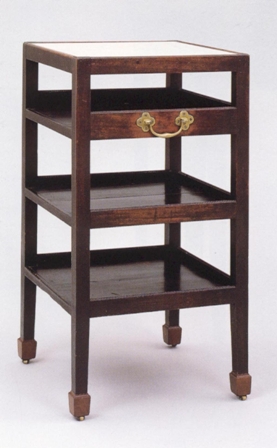Dumbwaiters
In Paris, Jefferson became accustomed to the French practice of using "dumbwaiters," small tiers of shelves on casters, for small dinner parties. These etageres were also known in England throughout the eighteenth century. Later, as president, Jefferson continued to employ dumbwaiters when he received dinner guests at the President's House. Margaret Bayard Smith remarked:
When he had any persons dining with him, with whom he wished to enjoy a free and unrestricted flow of conversation, the number of persons at the table never exceed[ed] four, and by each individual was placed a dumb-waiter, containing everything necessary for the progress of the dinner from beginning to end, so as to make the attendance of servants entirely unnecessary, believing as he did, that much of the domestic and even public discord was produced by the mutilated and misconstructed repetition of free conversation at dinner tables, by these mute but not inattentive listeners.[1]
In Paris, where Jefferson could entertain as many as twenty guests at dinner, he owned five dumbwaiters, but these were sold because they "were of the more common kind."[2] To replace them, he purchased four or more in Philadelphia as they were among his furnishings at his house at Gray's Ferry.[3]
Two of the five extant dumbwaiters have features that suggest that they are the products of the Monticello joinery: straight, slightly tapering legs; astragal molding on the top rails; ovolo molding on the side rails; and a double-scratch bead on the open end of the shelf. The other two dumbwaiters differ slightly. They have King of Prussia marble tops, brass bail handles on two sides, and legs that terminate in applied spade feet resting on casters. Only one of the mahogany dumbwaiters has its original spade feet; the others are later replacements. The fifth dumbwaiter has a wood and marble top but no spade feet. The comparatively unrefined workmanship suggests that they were made either in Monticello's joinery or possibly by two Philadelphia joiners named Joseph and Henry Ingle who performed cabinetwork for Jefferson in the early 1790s.
The dumbwaiter pictured [in the video] was made in the Monticello joinery for Jefferson's use at Poplar Forest, his farm and retreat in Bedford County. The dumbwaiter descended in the family of William Cobbs, who acquired Poplar Forest together with some of Jefferson's furnishings in 1828.
- Text from Stein, Worlds, 282-83
Further Sources
- Self, Robert L. and Susan R. Stein. "The Collaboration of Thomas Jefferson and John Hemings." Winterthur Portfolio vol. 33, no. 4 (1998): 233-48.
- Look for further sources in the Thomas Jefferson Portal.
References
- ^ Smith, First Forty Years, 387-88.
- ^ William Short to Jefferson, August 4, 1790, in PTJ, 17:315. Transcription available at Founders Online.
- ^ Philadelphia: house (plan), [1793], by Thomas Jefferson, N251; K120 [electronic edition], Thomas Jefferson Papers: An Electronic Archive (Boston: Massachusetts Historical Society, 2003).
